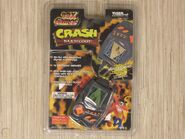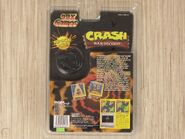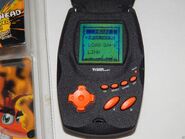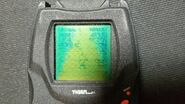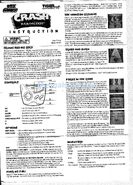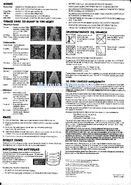Crash Bandicoot is a licensed platform game developed and published by Tiger Electronics and published by Universal Interactive in North America, released on a handheld dedicated console in 1998. It is the third game released in the Crash Bandicoot series overall, as well as the first to not be developed by Naughty Dog, the first to be released on a handheld console, the first spin-off of the franchise, and the first to feature a multiplayer option. Despite bearing the same name, the game is neither an adaptation nor port of the 1996 Crash Bandicoot game, featuring a distinct storyline and set of levels of its own.
Plot
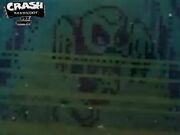
Photo of the original sprite of Mr. Crumb.
The ghost of a wealthy old man named Mr. Crumb, described as friendless and selfish throughout his life, continues to haunt his mansion after dying to protect the large amount of gold he left behind there. Mr. Crumb also woke the undead whilst on his deathbed, to help him guard the mansion and surrounding area once he was gone.
Crash, tempted by the allure of "forbidden treasure" and the rumours surrounding the mansion being haunted, dares to enter Mr. Crumb's mansion to try and collect it. Along the way, he finds himself up against Mr. Crumb's undead army.[1]
Characters
Playable
Bosses
Supporting
Gameplay
Crash Bandicoot is a platform game played from a third person perspective. The game is displayed from a pseudo-3D point of view, but uses
Game images from the manual. The various objects that Crash will have to retrieve to advance through the levels can also be seen.
2D sprites, in the style of mobile games such as Crash Twinsanity 3D. Unlike in that game, however, the player does have full control over the main character's movements, with the exception of being able to walk backwards to a previously visited area due to system limitations. The player controls Crash and, able to move forward and sideways, has to traverse through a series of levels involving skillfully timed jumping and use of his spin attack to get around obstacles. The game's main objective is to succeed in reaching Mr. Crumb's mansion and taking his treasure, despite the ghouls, zombies and other undead creatures that have been sent to stop Crash along the way. Primarily, Crash progresses on his journey to the mansion by collecting items required to open up new routes.
The game is divided into four themed areas, each representing a part of Crash's journey to reach the mansion from the outside. These are Haunted Forest, Catacombs, Graveyard, and finally The Condemned Mansion. From a hub, referred to as The Mansion Grounds, Crash can select the order in which he plays through these areas.
There are no levels in the traditional sense. Rather, each area is split into three subsections called paths. As Crash reaches the end of a path, he'll come to a fork in the road. Every time a fork in the road occurs, the player will be awarded with an item if they choose to take the right fork. If they choose the left fork, they'll be directed to the next path, but only be able to continue if they gained a particular required item from an earlier occasion when they selected the right fork. This effectively adds more replay value, as it means one path must be revisited several times in order to be able to gain the item needed to progress further.
The collectable items awarded at a right fork in the road are all arbitrary objects, such as a torch, which are stored in an inventory once gained. The inventory can be brought up at any time to select and use the items.
If the player manages to get to the end of all three paths in an area, Crash will face a boss. The first three areas' bosses are minions of Mr. Crumb: "Thorn Thing" (a dead tree), "Grumbler" (a mummy) and "Digger" (a skeleton). The last, at the end of The Condemned Mansion, is the ghost of Mr. Crumb himself.
As in the console games which preceded it, crates are scattered around which either contain wumpa fruit, one hundred of which grant Crash an extra life, or an Aku Aku mask that grants him temporary protection from enemies. TNT crates return too, which in contrast to the others harm Crash. Beyond these, others common in the series, such as the arrow crate and Nitro Crate, are not included this time. As well as this, it isn't compulsory to break every crate in a level, nor is any collectable rewarded if the player does this, as was the case in the first two games.[2]
Via a separately sold Web Link package, which contained a CD and modem, a Crash Bandicoot handheld could be plugged into a computer. From here, the player could then upload their high score to a leaderboard on the official 99X Games website. The Web Link also alleged to allow the player to download "hidden codes and features" to their handheld through the official website, in the case of each 99X title.[3] However, as the website has long since been obsolete, it's unclear what if any extra content there was for Crash Bandicoot in particular, and either way it is now impossible to download unless the files resurface online at a later date. The manual itself only refers to "secret codes".[4]
Multiplayer
A cable came free with each copy of the game, which can be used to connect two Crash Bandicoot handhelds together. Multiplayer consists of the playing the same single player campaign, but once connected, the two players compete alongside each other with the handhelds recording their progress. Whoever lasts the longest without reaching game over, in turn gaining the highest score, wins.
Development
Its release came as part of a series by Tiger Electronics named 99X. Unlike typical releases from the company, which were often low-end gaming systems with LCD screens, these were a series of handhelds fitted with a dot-matrix video display at an 80x80 screen resolution[5], allowing for a wide variety of backgrounds and different gameplay for a single game. Although running a software program stored in ROM, the systems were dedicated consoles similar to the later plug-and-play TV games of the 2000s decade. On release, the Crash Bandicoot handheld retailed at a higher price than average for a handheld holding a standalone game, reflecting the greater level of quality, at $29.99. This was in fact more expensive than the retail price of some games on their earlier Game.com console at the time[6]. Crash Bandicoot was one of four handhelds ultimately released in the 99X line, the other three being Mutoids, and ports of Resident Evil 2 and WCW/nWo Thunder.
News of the 99X series was first announced in February 1998, at which point only Mutoids was mentioned[7]. Later, in July of that year, a member of staff from Tiger revealed in an interview with a fan on the website Slight's Compendium that they now "had the license" to make games based on the Crash Bandicoot IP, and that the next in the 99X line "would be Crash Bandicoot"[8]. The following month, Hasbro, who had just recently acquired Tiger Electronics, registered the web domain for the official 99X Games website, and it went live[9]. It is unclear at exactly what point Crash Bandicoot was first released from here onwards, but via The Internet Archive, it can be seen that the game was available from at least as early as November 11, 1998 on Tiger's US Game.com store[10][11]. Depending on when the game was first sold between August and November of 1998, it's likely that the game's release narrowly predated that of Crash Bandicoot: Warped.
Gallery
External links
Tiger 99X Series Official Website (Archive)
Full Walkthrough of the game (YouTube)
Interview with a developer of Crash 99X and the Mr. Crumb character.
Trivia
- Crash Bandicoot 99X is the first game not to be developed by Naughty Dog.
- Apart from Crash and Aku Aku, no characters from previous games are present.
- Although developed and published by Tiger Electronics, in some areas of America and Europe the game is published by Universal Interactive Studios.
References
- ↑ Scan of the game's manual, including game's plot Hasbro (Official website). Accessed February 19, 2019.
- ↑ Scan of the game's manual, including detailed game instructions Hasbro (Official website). Accessed February 19, 2019.
- ↑ Official 99X Games website's download section, mentioning "hidden codes and features" (Archive copy) 99xgames.com, via The Internet Archive. Accessed February 19, 2019.
- ↑ 99X Games Web Link package download page, including external links to the Crash Bandicoot leaderboard (Archive copy) 99xgames.com via The Internet Archive. Accessed February 19, 2019.
- ↑ Report on Tiger 99X specifications and Mutoids, April 28, 2000 GameSpot. Accessed February 19, 2019.
- ↑ Tiger Electronics Online Store (1990s Archive Copy) Via The Internet Archive. Accessed February 19, 2019.
- ↑ "Tiger Activating Mutoids In '98 For Electronic Games", report on the upcoming Tiger 99X series, February 2, 1998 AdAge. Accessed February 19, 2019.
- ↑ Interview with Tiger Electronics staff member, July 2, 1998 Slight's Compendium. Accessed February 19, 2019.
- ↑ Documentation of the history of the 99xgames.com domain Whois. Accessed February 19, 2019.
- ↑ Earliest archive of the official 99X Games website, dated November 11, 1998 99xgames.com via The Internet Archive. Accessed February 19, 2019.
- ↑ Direct link to the Tiger Electronics US store, via 99X Games archive link in reference #7, November 11, 1998 Via The Internet Archive. Accessed February 19, 2019.

